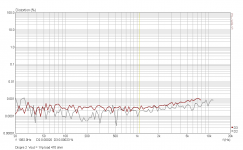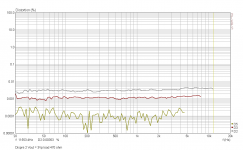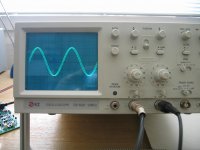Now is probably high time to say that 2 versions with different loopgain, i.e. different feedback, really do sound different, and the difference can be hardly explained by THD measured as 0.00025% in one case:
That is very interesting. Which was 'subjectively better' to you? Do you have a theory why they sound different?
Pavel,
I have been listening to one of your V4 preamps for the last couple of weeks. I must say that I am very happy with your creation. Kudos to you and thank you!
I have been listening to one of your V4 preamps for the last couple of weeks. I must say that I am very happy with your creation. Kudos to you and thank you!
Carl,
thank you for the positive feedback, this is always very encouraging.
Best regards,
Pavel
thank you for the positive feedback, this is always very encouraging.
Best regards,
Pavel
pre standard two
Hi Pavel !
Can you give out some data?
Simplified schematic would be nice. Or at least the count of stages and in what
configuration you use Hit. mosfets in the output: CS or CD? Do you use NFB?
Hi Pavel !
Can you give out some data?
Simplified schematic would be nice. Or at least the count of stages and in what
configuration you use Hit. mosfets in the output: CS or CD? Do you use NFB?
Bob Cordell sometimes speak about HF THD measurements, like THD30. I have decided to measure the Dispre 2 at 100kHz. However, it is not so easy to get enough resolution. First I would like to show measurement of generator itself at 100kHz:
I would like to know what the delay at 100kHz, which has output stage.
Thank
Not sure what you mean. The time delay at 100kHz at the output of the complete Dispre 2 V4 preamplifier vs. input, without input 220pF filter capacitor, is 310 nanoseconds.
Not sure why you are asking, though.
Not sure why you are asking, though.
I believe that the delays and the sine of the corresponding angle is crucial for the assessment of listening and distortion of amplifiers.
Here is 11 °, so 19% of maximum value, then the square is 3.7%.
Here is 11 °, so 19% of maximum value, then the square is 3.7%.
Last edited:
Federmann -
the same, 310ns time delay (at 100kHz, but not only at this frequency) has a pure RC filter built of 1kohm resistor and 320pF capacitor. The -3dB frequency of such LP filter is 500kHz.
In case you would like to offer some of your unique theories, please open your separate thread, as suggested by danhard.
the same, 310ns time delay (at 100kHz, but not only at this frequency) has a pure RC filter built of 1kohm resistor and 320pF capacitor. The -3dB frequency of such LP filter is 500kHz.
In case you would like to offer some of your unique theories, please open your separate thread, as suggested by danhard.
Yes. There is a slight addition from input RC filter. Anyway, this 400ns does not depend neither on frequency, nor on output amplitude, up to several hundreds of kHz. Then, for frequencies of hundreds kHz and more the time delay gets shorter and shorter. The circuit behaves as a linear passive circuit. Therefore I do not understand Federmann's question. No one hears 400 nanoseconds of absolute time delay. Only channel difference in time delay would bring an audible difference, and it should be 2 microseconds or more to be audible. Again, we face a wrong assumption here.
Last edited:
Delays do not care, that creates the input R-C circuit. I do not care, how the listener hears. I'm interested in how to show a delayed signal the sum input signal.
Federmann, if you mean a contribution in time delay of an output stage in isolation, it is several nanoseconds, plus time delay of 15ohm + 68pF RC low-pass circuit.
Hello PMA,
I took a look at your Dispre2 circuit. Is there any reason why you use 2 pots in parallel on the input of your line amp? Is it for reliability? Also, I thought the input z was 20 or 22k, but it looks like 2 10k pots in parallel, so this is 5k per channel. Am I reading it right?
What are your thoughts on the Alps Blue Velvet pot? I am using a 25k on my op-amp based pre-amp - no problems so far.
I took a look at your Dispre2 circuit. Is there any reason why you use 2 pots in parallel on the input of your line amp? Is it for reliability? Also, I thought the input z was 20 or 22k, but it looks like 2 10k pots in parallel, so this is 5k per channel. Am I reading it right?
What are your thoughts on the Alps Blue Velvet pot? I am using a 25k on my op-amp based pre-amp - no problems so far.
🙂
These 2 pots are only in schematics. They are 2 different library components with different pin distances. Of course you make a choice of only one on PCB.
As a standard, there is a blue Alps. Those who cannot afford this pot can use 16mm cheap one, like Piher, but channel volume matching is poor then.
These 2 pots are only in schematics. They are 2 different library components with different pin distances. Of course you make a choice of only one on PCB.
As a standard, there is a blue Alps. Those who cannot afford this pot can use 16mm cheap one, like Piher, but channel volume matching is poor then.
Attachments
Last edited:
- Home
- Source & Line
- Analog Line Level
- New DISPRE preamp, successor to previous popular version



